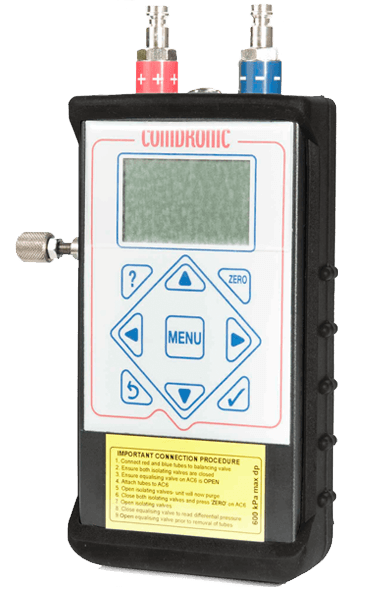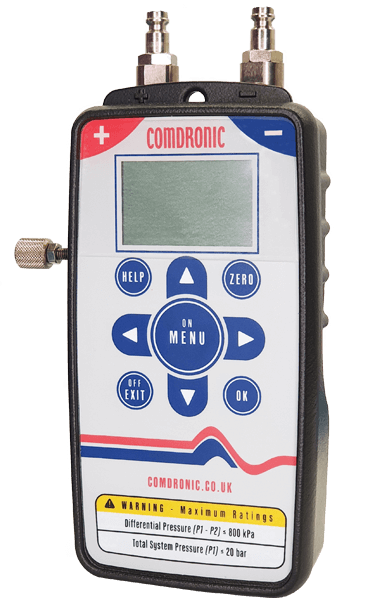Legislation has raised the issue of working at height on ladders, the traditional tool of the commissioning engineer. Using water boxes in plant rooms or in installations where the unit cannot be secured makes the whole job of commissioning less efficient.
In addition to the physical size there is now a groundswell of opinion that mercury should no longer be used due to it being a class A poison. In liquid form the mercury can also pose an electrical risk if it is allowed to escape from its enclosure. For this reason it is very difficult to obtain supplies as the courier companies are not prepared to handle the material.
From a practical point of view there are also some limitations when using fluid manometers. The function of the commissioning engineer is to ensure that the system being set-up functions in accordance with design, in order to do this the reading taken from balancing devices need to relate to flow of water. The use of a fluid manometer just gives the differential pressure across the device. In order to establish the flow it is necessary to have present the Kvs value for the valve or measuring device. Most commissioning engineers will have this data but it means that yet more information needs to be carried on site.
The calculations needed for the derivation of flow are quite simple when using fixed Kvs devices but become much more time consuming when variable Kvs devices are used.
Electronic Manometers
In addressing these practical shortfalls the electronic manometer was developed. Electronic Manometers have been used for commissioning within the HVAC industry since the late 1970’s however it has only been in the last 10 years that sensor technology and programmable electronics have allowed truly practical devices to be designed.
Early electronic meters suffered from failures of sensors which had been selected to suit the differential pressure range up to 200 kPa. Electronic devices converting the signals from these sensors were limited and as such it was necessary for sensors to be selected with a limited range. Unfortunately, sensors that were appropriate were also very fragile and susceptible to rupture when the maximum differential pressure was exceeded. Sensor failure was a common occurrence particularly when one of the connection tubes was removed from the valve – this placed static pressure on one side of the sensor with resulting failure.
The major benefits afforded the user with electronic meters are primarily associated with the ability to take the differential pressure reading and equate it to the flow coefficients (Kvs) stored in the database. By carrying out the calculations at high speed the meter effectively displays flow in real time. If the user is measuring with variable orifice valves the handwheel position can be entered and again, the meter will calculate the flow.
State of the art commissioning meters such as the AC6/AC7, use sensors selected as the most appropriate for the pressure ranges being measured. The latest digital devices allow extremely high resolution and accuracy.
The database of valves is continually growing and currently stands at approximately 6,500 valves from around the world.
Future Developments
Electronic commissioning meters such as the AC6/AC7 are already highly developed with a large range of features for the commissioning engineer to explore. The latest addition of data associated with auto balancing valves is an interesting area of development which will allow the user to verify performance of this very useful type of valve. Comdronic Ltd is continually developing new functionality to enhance the commissioning process but the big changes are coming in the form of the type of system being constructed.
Variable volume systems utilizing variable speed pumps are presenting the commissioning engineer with new challenges. Many systems are now being designed with differential pressure control valves (DPCV’s) at key points in the system. In order to fully understand the dynamics of the system the commissioning engineer is often required to measure pressure across DPCV’s and this may require a meter to read well over the 65kPa maximum pressure for the mercury manometer. In addition to the DPCV’s it is important to be able to measure flow and return differentials so that the system can be correctly set up to minimise the pump power.
Comdronic Ltd, with a commitment to continuous product development and customer support, has established itself as the leading designer and manufacturer of of water-based commissioning systems in the UK.
Our Manometers
Ambient Temperature Limitations
+2C to +35C
+2C to +35C
+2C to +45C
+2C to +45C
Maximum Total System Pressure
10 bar
20 bar
10 bar
20 bar
Range of Operation
0.5 kPa – 250 kPa
1.0 kPa – 800 kPa
0.5 kPa – 250 kPa
1.0 kPa – 800 kPa
Measurement Accuracy
+/- 1% of reading or +/- 0.1 kPa, whichever is the greater
+/- 1% of reading or +/- 0.2 kPa, whichever is the greater
+/- 1% of reading or +/- 0.1 kPa, whichever is the greater
+/- 1% of reading or +/- 0.2 kPa, whichever is the greater
Price
£1,860.00 + VAT
£1,860.00 + VAT
£1,980.00 + VAT
£1,980.00 + VAT
Measurement Range
0.5 kPa – 250 kPa
Accuracy
+/- 1% of reading or +/- 0.1 kPa, whichever is the greater
Maximum Allowable System Pressure
10 bar
Recommended Ambient Conditions
+2C to +35C
Recommended Service Interval
Every 12 months
Price
£1,860.00 + VAT
Measurement Range
1.0 kPa – 800 kPa
Accuracy
+/- 1% of reading or +/- 0.2 kPa, whichever is the greater
Maximum Allowable System Pressure
20 bar
Recommended Ambient Conditions
+2C to +35C
Recommended Service Interval
Every 12 months
Price
£1,860.00 + VAT
Measurement Range
0.5 kPa – 250 kPa
Accuracy
+/- 1% of reading or +/- 0.1 kPa, whichever is the greater
Maximum Allowable System Pressure
10 bar
Recommended Ambient Conditions
+2C to +45C
Recommended Service Interval
Every 12 months
Price
£1,980.00 + VAT
Measurement Range
1.0 kPa – 800 kPa
Accuracy
+/- 1% of reading or +/- 0.2 kPa, whichever is the greater
Maximum Allowable System Pressure
20 bar
Recommended Ambient Conditions
+2C to +45C
Recommended Service Interval
Every 12 months
Price
£1,980.00 + VAT

